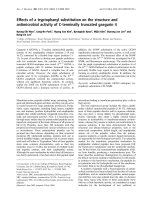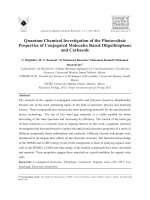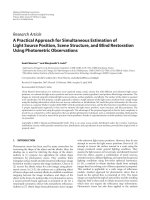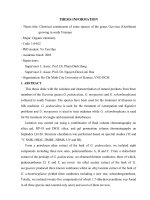A quantum chemical research of structure and aromaticity of some boron clusters
Bạn đang xem bản rút gọn của tài liệu. Xem và tải ngay bản đầy đủ của tài liệu tại đây (7.36 MB, 163 trang )
MINISTRY OF EDUCATION AND TRAINING
QUY NHON UNIVERSITY
DUONG VAN LONG
A QUANTUM CHEMICAL RESEARCH OF STRUCTURE AND
AROMATICITY OF SOME BORON CLUSTERS
DOCTORAL DISSERTATION: Theoretical and Physical Chemistry
MINISTRY OF EDUCATION AND TRAINING
QUY NHON UNIVERSITY
DUONG VAN LONG
A QUANTUM CHEMICAL RESEARCH OF STRUCTURE AND
AROMATICITY OF SOME BORON CLUSTERS
Major: Theoretical and Physical Chemistry
Code No: 9440119
Reviewer 1: Prof. Dr. Nguyen Ngoc Ha
Reviewer 2: Prof. Dr. Tran Thai Hoa
Reviewer 3: Prof. Dr. Duong Tuan Quang
Supervisors:
1. Assoc. Prof. Dr. Nguyen Phi Hung
2. Prof. Dr. Nguyen Minh Tho
BINH DINH – 2023
DECLARATION
This dissertation was written on the basis of research work carried out at Quy Nhon
University, Binh Dinh province, under the supervision of Professor Nguyen Minh
Tho and Associate Professor Nguyen Phi Hung.
I hereby declare that the results presented are original from my own research work.
Most of them were already published in peer-reviewed international journals.
For the use of the results from joint papers, I received permissions from my coauthors.
Quy Nhon Binh Dinh
15 January 2024
Author
Duong Van Long
ACKNOWLEDGEMENTS
I would like to express my sincere gratitude to professors and colleagues at Quy
Nhon University, my family and friends who have accompanied me throughout the long
years of pursuing a doctoral program.
In particular, I would like to express sincere thanks to the professors and faculty
staffs of the Department of Chemistry, Faculty of Natural Sciences and Postgraduate
Training Office of Quy Nhon University for their support, understanding and for creating
conditions for me to overcome obstacles caused by the COVID-19 pandemic.
I would like to express my deepest gratitude to my supervisors, Profs. Nguyen Minh
Tho and Nguyen Phi Hung, for their invaluable guidance and support throughout my
academic journey. Prof. Tho and Prof. Hung have been my scientific mentor since the
beginning of my academic career, and I am truly grateful for their unwavering support and
encouragement. They provided me with the foundation and skills necessary to succeed in
my academic pursuits. Their expertise and mentorship have been instrumental in shaping
my research and helping me achieve my academic goals. I am honoured to have the
opportunity to work under the guidance of both Professors Tho and Hung and I am forever
grateful for their constant support.
Thank you, Nguyen Ngoc Tri, Phan Dang Cam Tu, My Phuong Pham Ho and
Nguyen Minh Tam, for sharing and accompanying me on my academic path.
I would like to express my debt to my parents for their unconditional love and
support. Their guidance, sacrifices and encouragement have been instrumental in shaping
me into the person I am today. Thank you, Mom and Dad, for everything.
I would also like to thank my wife and my little son for their love and
encouragement. My wife has been a constant source of inspiration and support. She has
stood by my side through thick and thin, even during long nights when she had/has to
listen to the sound of clattering keyboards while I was, and I am, working on my academic
projects. I cannot thank her enough for her patience, understanding and foremost love. And
my little son, you are the driving force for me to move forward, to achieve what we have
now and in the future.
I dedicate this thesis, my great achievement, to my family, and hope to continue
making them proud.
Table of Contents
List of symbols and notations .......................................................................................... i
List of Figures ................................................................................................................ iii
List of Tables.................................................................................................................. ix
GENERAL INTRODUCTION ....................................................................................... 1
A.
Research introduction......................................................................................1
B.
Objectives and scope of the research ..............................................................2
C.
Novelty and scientific significance .................................................................2
Chapter 1. DISSERTATION OVERVIEW ......................................................5
1.1.
Overview of the research .....................................................................5
1.2.
Objectives of the research ...................................................................9
1.3.
Research content ..................................................................................9
1.4.
Research methodology ......................................................................10
1.4.1. Search for lower-lying isomers .....................................................10
1.4.2. ELF – The electron localization function .....................................10
1.4.3. Ring current maps .........................................................................11
1.4.4. Bond order and net atomic charge ................................................14
1.4.5. The Hückel and Baird rules ..........................................................14
1.4.6. Ribbon aromaticity .......................................................................20
1.4.7. Disk aromaticity............................................................................30
1.4.8. Hollow cylinder model .................................................................36
Chapter 2.
THEORETICAL
BACKGROUNDS
AND
COMPUTATIONAL METHODS ....................................................................40
2.1.
Schrödinger equation .........................................................................40
2.2.
The Born–Oppenheimer Approximation ..........................................40
2.3.
Ab initio computational method ........................................................42
2.4.
The Hartree-Fock Method .................................................................43
2.5.
Density Functional Theory ................................................................44
2.6.
Benchmarking the functional and basis set in DFT ..........................48
2.7.
Post-Hartree-Fock methods ...............................................................51
Chapter 3. RESULTS AND DISCUSSION ...................................................54
3.1.
The Hückel rule and the ribbon model: The cases of B2Si3q and
B3Si2p clusters. ...............................................................................................54
3.1.1. Motivation for the study ...............................................................54
3.1.2. The benchmarking tests ................................................................57
3.1.3. Ribbon aromaticity model versus the Hückel electron count .......64
3.1.4. Concluding remarks ......................................................................76
3.2.
The disk aromaticity on the quasi-planar boron cluster B700/2-..........77
3.2.1. Motivation of the study .................................................................77
3.2.2. The quasi-planar B700/2- .................................................................79
3.2.3. Disk model and electron count rule ..............................................82
3.2.4. Concluding remarks ......................................................................86
3.3.
Binary boron lithium clusters B12Lin with n = 1–14: the disk-cone
model for the B12Li4 cluster ..........................................................................86
3.3.1. Motivation of the study .................................................................86
3.3.2. The growth pattern of B12Lin with n = 0 – 14 ...............................88
3.3.3. Relative stabilities of clusters .......................................................95
3.3.4. Chemical Bonding ........................................................................97
3.3.5. A mixed cone-disk model ...........................................................101
3.3.6. Concluding remarks ....................................................................106
3.4.
B14FeLi2 and the hollow cylinder model .........................................106
3.4.1. Motivation of the study ............................................................106
3.4.2. Stability of B14FeLi2 and its potential applications ....................107
3.4.3. Concluding remarks ....................................................................116
Chapter 4. GENERAL CONCLUSIONS AND FUTURE DIRECTIONS ..117
4.1.
General Conclusions........................................................................117
4.2.
Future Directions .............................................................................119
LIST OF PUBLICATIONS CONTRIBUTING TO THE DISSERTATION ............ 121
REFERENCES ............................................................................................................ 122
Appendix ..................................................................................................................... 138
List of symbols and notations
2D
Two dimensional
3D
Three dimensional
ACID
Anisotropy of the induced current density
ADE
Adiabatic detachment energy
AdNDP
Adaptive Natural Density Partitioning
AO
Atomic orbital
ASBO
Average of the sum of the bond orders
CASSCF
Complete Active Space Self-Consistent Field
CBS
Complete basis set
CC
Coupled cluster
CCSD
Coupled cluster including singles and doubles
CCSD(T)
CCSD with a perturbative triples correction
CI
Configuration Interaction
CMO
Canonical Molecular Orbital
CTOCD-DZ2
Continuous transformation of the origin of the current density diamagnetic zero, with shifting the origin toward the nearest nucleus
DFT
Density functional theory
DM
Disk model
DR
Double ring
ELF
Electron localization function
GA
Genetic algorithm
GGA
Generalized gradient approximation
GTO
Gaussian-type orbitals
HCM
Hollow cylinder model
HF
Hartree-Fock
HLG
Frontier orbital (HOMO – LUMO) energy gap
HOMO
Highest Occupied Molecular Orbital
i
IEv
Vertical ionization energy
IR-UV2CI
Resonant infrared-ultraviolet two-color ionization spectroscopy
LCAO
Linear combination of atomic orbitals
LDA
Local density approximation
LUMO
Lowest Unoccupied Molecular Orbital
MBPT
Many-body perturbation theory
MEGA
Mexican Enhanced Genetic Algorithm
meta-GGA
Meta-generalized gradient approximation
MO
Molecular orbital
MPn
n-order Møller-Plesset perturbation method
MRCI
Multireference Configuration Interaction
NAC
Calculated net atomic charged
NICS
Nuclear independent chemical shift
PES
Photoelectron spectroscopy
PSM
Phenomenological shell model
QP
Quasi-planar
RMS
Root mean square
RSS
Residual sum of squares
SBO
Sum of bond orders
SOMO
Singly Occupied Molecular Orbital
SPION
Superparamagnetic iron oxide nanoparticles
STO
Slater-type orbitals
TD-DFT
Time dependent density functional theory method
TEAv
Vertical two-electron affinity
UV
Ultraviolet
UV-Vis
Ultraviolet-Visible
VASP
Vienna ab initio simulation package (VASP)
VDE
Vertical detachment energy
ii
List of Figures
Figure 1.1. Illustration of a genetic algorithm (GA) procedure ([49])......................10
Figure 1.2. The current density maps of π electron contribution of a) C4H4 and b)
C6H6 plotted by both SYSMOIC and ACID packages. ............................................13
Figure 1.3. The π molecular orbitals of benzene according to the Hückel theory. The
dashed line represent the energy of an isolated p orbital, and all orbitals below this
line are bonding. All orbitals above it are antibonding. ............................................19
Figure 1.4. MO energy diagrams of C4H4 (in both singlet and triplet states), C6H6,
C8H8 (in both singlet and triplet states), and C10H8. The blue/red labels indicate the
aromatic/antiaromatic species. ..................................................................................19
Figure 1.5. Calculated curves as a function of size n for (a) adiabatic detachment
energies of Li2BnH2- (n = 6–22) ribbon clusters, and (b) Ionization energies of
Li2BnH2 (n = 6–22) ([40]). ........................................................................................21
Figure 1.6. The electron configuration π6σ4 of the ribbons B10H22- and B11H2-........22
Figure 1.7. The potential-energy function of the one-dimensional model. ..............23
Figure 1.8. A comparison between the 𝑙𝜋, 𝑙𝜎 and the distance of between the two
most distant B atoms of B14H22-. ...............................................................................25
Figure 1.9. a) The ribbon structure of B14H22-. b) ELFσl plot for B14H22-, and c) ELFπ
(yellow basins) and ELFσd (green basins) are plotted simultaneously for B14H22-. ..26
Figure 1.10 a) The ribbon structure of the singlet B12H22-; b) ELFσl plot for the
singlet B12H22-, and c) ELFπ (yellow basins) and ELFσd (green basins) are plotted
simultaneously for the singlet B12H22-.......................................................................28
Figure 1.11. a) The ribbon structure of the triplet B12H22-. b) ELFσl plot for the
triplet B12H22-. c) ELFπ (yellow) and ELFσd (green) are plotted simultaneously for
the triplet B12H22-. d) and e) are the ELFπ and ELFσd plotted simultaneously for the
triplet B12H22- from 𝛼 and 𝛽 electrons, respectively. ................................................29
Figure 1.12. The Bessel functions 𝐽𝑚𝑥 with 𝑚 = 0, 1, and 2. ...............................34
iii
Figure 1.13. Symmetries of some wavefunctions in the disk model. The two colours
red and blue indicate the opposite signs of the wave functions. ...............................35
Figure 1.14. Hollow cylinder model. The hollow cylinder's height is L, radius is R,
inner radius is R0, and outer radius is R1. Particle's movement is limited from R0 to
R1, with R0 = R – r, R1 = R + r where r is called the active radius of the hollow
cylinder. .....................................................................................................................36
Figure 1.15. The variation of function 𝑓𝜗𝑙𝑛𝑅 in equation (1.77) according to 𝜗𝑙𝑛𝑅
with 𝜀 = 0.5 and 𝑙 =±1 or 𝑙 =±2. ...........................................................................38
Figure 3.1. Photoelectron spectra of B2Si3- clusters recorded with 266 nm photons
[109]. .........................................................................................................................55
Figure 3.2. (a) Comparison of IR-UV2CI spectrum of B2Si3 with IR absorption
spectra calculated for the low-energy structures 3.2a-e [110]. (b) Relaxed 3.2.a
isomer was obtained using the CCSD method or different DFT functionals [111]. 55
Figure 3.3. An illustration of clusters with 2 π electrons and 2 σ delocalized
electrons. ...................................................................................................................57
Figure 3.4. Shapes of low-lying isomers of B2Si3q clusters with q going from -2 to
+2. Geometry optimizations are carried out using the TPSSh/6-311+G(d) level of
theory. Relative energies (kcal/mol) are computed using three different methods and
will be elucidated in the text. ....................................................................................58
Figure 3.5. Shapes of low-lying isomers of B3Si2p clusters with p going from -3 to
+1. Geometry optimizations are carried out using the TPSSh/6-311+G(d) level of
theory. Relative energies (kcal/mol) are computed using three different methods and
will be elucidated in the text. ....................................................................................59
Figure 3.6. A pathway illustrating the evolution leading to the B2Si3q from the
trianionic ribbon II.B3Si23- in which a B- unit is replaced by an isovalent Si atom at
two different positions leading to two isomeric types, namely ribbon (R) and Hückel
(H). ............................................................................................................................65
Figure 3.7. Delocalized π and delocalized σ CMOs of a) II.B3Si23-, b) I.B2Si32- and
c) II.B2Si32- isomers. The atom positions are labelled by a, b, c, d and e. ................66
iv
Figure 3.8. a-f) Ribbon structures of B3Si2p. i) Bond lengths (Å) and bond order (in
brackets) are given by blue numbers and net atomic charges are given by red
numbers. ELF isosurfaces under ii) top and iii) side view. iv) Electron
configurations. Energy levels with green arrow(s) belong to delocalized CMOs. ...69
Figure 3.9. The representation of the self-locking phenomenon in the ribbon
structures of B7H2-, B8H2, B9H23-, B9H2Li2-, and B10H2-. B-B bond lengths are
assigned by colour range from red to blue: 1.50 Å to 1.80 Å. Nimag indicates the
number of negative frequencies of the structure. ......................................................70
Figure 3.10. The lowest-lying isomers of B3Si2Li2- shares the same B3Si23- ribbon
frame and two decorative Li+ ions in different positions. Relative energies are
calculated at TPSSh/6-311+G(d) + ZPE level of theory. .........................................71
Figure 3.11. ELFπ maps for II.B3Si23- and I.B2Si32-..................................................72
Figure 3.12. a-f) Nanoribbon structures of B2Si3q. Plotting conventions as Figure
3.8. .............................................................................................................................73
Figure 3.13. a-e) The Hückel type of B2Si3q i) Bond lengths (Å) and bond order
(given in braces) are given by blue numbers and net charges are given by red
numbers. ELF isosurfaces of ELF = 0.8 under ii) top view and iii) side view. iv)
Electron configurations. Energy levels with green arrow(s) belong to π and σ
delocalized CMOs while energy levels with grey arrows point out localized CMOs.
...................................................................................................................................74
Figure 3.14. A quasi-planar structure consisting of 70 boron atoms was generated
using the topological leapfrog algorithm starting from an initial B16 form with 13
vertices (the atom with yellow glow). .......................................................................79
Figure 3.15. The selection of energetically favourable isomers of B70. The
abbreviation "3D" refers to three-dimensional isomers, while "QP" denotes quasiplanar isomers. The numbers, represented by "n = 1, 2, 3, …," indicate the relative
energy order of each 3D or QP isomer. ....................................................................81
Figure 3.16. Correspondence between the calculated π-MOs of the B702- dianion
with the energy levels of the disk model. ..................................................................83
v
Figure 3.17. Correspondence between the π-MOs of B702- with the non-degenerate
energy levels of the disk aromaticity model. ............................................................85
Figure 3.18. Total magnetic current density maps of a) the B702- dianion, and b) the
triplet QP.1 B70. Vectors are plotted on a surface at 1 Å above the framework of the
structure with the external magnetic field perpendicular to the molecular plane
directed towards the reader. ......................................................................................85
Figure 3.19. Geometry, point group and relative energy (kcal/mol, (U)CCSD(T)/ccPVTZ + ZPE) of B12Lin with n = 0 – 6. Relative energies at TPSSh/6-311+G(d) +
ZPE are given in parentheses. TPSSh/6-311+G(d) optimized geometries are used. 90
Figure 3.20. Geometry, point group and relative energy (kcal/mol, (U)CCSD(T)/ccPVTZ + ZPE) of B12Lin with n = 7 – 10. Relative energies at TPSSh/6-311+G(d) +
ZPE are given in parentheses. TPSSh/6-311+G(d) optimized geometries are used. 92
Figure 3.21. Geometry, point group and relative energy (kcal/mol, (U)CCSD(T)/ccPVTZ + ZPE) of B12Lin with n = 11 – 14. Relative energies at TPSSh/6-311+G(d)
+ ZPE are given in parentheses. TPSSh/6-311+G(d) optimized geometries are used.
...................................................................................................................................94
Figure 3.22. a) Binding energy per atom; b) Average of sum of bond orders (ASBO)
values; c) HOMO – LUMO gaps; and d) Dissociation energy (left y-axis) and
second-order energy difference variation (right y-axis) of the binary B12Lin (n = 0–
14 clusters). ...............................................................................................................97
Figure 3.23. MO energy diagrams of the 4C, 8A and 14C-Th isomers. The line
levels are full occupied MOs, and the dash line levels are unoccupied CMOs. The
brown, red, blue, green, and black colour points out the S, P, D, F and G subshells,
correspondingly. ........................................................................................................98
Figure 3.24. The ELF map of 14C-Th. The red and yellow basins indicate the B and
Li positions, respectively. The conventional covalent basins are coloured by green
while the lone pair basins coloured by purple...........................................................99
vi
Figure 3.25. The ELF map of 8A. The red and yellow basins indicate the B and Li
positions, respectively. The conventional covalent basins are coloured by green
while the lone pair basins coloured by purple.........................................................100
Figure 3.26. Optimized adsorption configurations of a) 8A-8H2, b) 8A-16H2, c) 8A24H2, d) 8A-32H2, and e) 8A-40H2 (wB97XD/6-311++G(2d,2p)). .......................101
Figure 3.27. The lowest-energy structures of the isoelectronic B13Li and B12Li4
clusters. ....................................................................................................................102
Figure 3.28. Valence MOs and LUMO of the B13Li cluster assigned within the
circular disk model. H stands for HOMO and L stands for LUMO. ......................103
Figure 3.29. The total current density maps of a) B13Li and b) B12Li4 and the c) π
and d) σ current density maps of B13Li. External magnetic field vector is present by
the blue arrow. Vectors are plotted on a surface having the cone shape at 1 Å inside
B-cone framework. ..................................................................................................104
Figure 3.30. 2σ and 3σ-orbitals of B202- and B13Li under the top view and side view.
.................................................................................................................................105
Figure 3.31. The lowest-lying isomer of B14Fe [146]. ............................................107
Figure 3.32. Optimized structures of lower-energy isomers of B14FeLi2; E
values are in kcal/mol from TPSSh/def2-TZVP energies with ZPE corrections....108
Figure 3.33. Formation of MOs of B14FeLi2 from MOs of singlet B14 skeleton and a
contribution from d-AO of Fe atom. Some MOs of the singlet B14 skeleton are
assigned by hollow cylinder model. ........................................................................109
Figure 3.34. ACID map of Li2FeB14 from a) top view and b) side view. .........111
Figure 3.35. ACID isosurface (isovalue = 0.05) of three valence MOs sets of
B14FeLi2 on the view from Li-Fe-Li axis (Oz axis) including a) localized set, b)
tangential set and c) radial set. ................................................................................112
Figure 3.36. Predicted electronic absorption spectrum of the teetotum B14FeLi2
(TPSSh/def2-TZVP). ..............................................................................................113
Figure 3.37. Optimized structure of the designed [Li-B14Fe-Li]-[B14Fe]-[Li-B14FeLi] wire. ...................................................................................................................115
vii
Figure 3.38. Optimized structures of (I) B28Fe2Li2Mg, (II) B42Fe3Li2Mg2, (III)
B56Fe4Li2Mg3, and (IV) B70Fe4Mg4Li2 nanowires in antiprism and prism forms. .115
viii
List of Tables
Table 1.1. First three roots (𝛼𝑚, 𝑛𝑅) of the Bessel functions of the first kind, with
the integer constant 𝑚 ranging from 0 to 4. .............................................................34
Table 3.1. Deviations of single-point (U)CCSD(T)/CBS total energies (kcal/mol) of
the considered structures computed using geometries optimized by different DFT
levels..........................................................................................................................61
Table 3.2. Comparison of two PES peaks of B2Si3- ([109]) to calculate VDEs and
ADEs (eV) using different functionals with 6-311+G(d) basis set and
CCSD(T)/aug-cc-pVTZ for both anionic isomers I.B2Si3- and II.B2Si3-..................62
Table 3.3. Comparison of IR-UV2CI spectra of B2Si3 (ref. [110]) with harmonic
vibrational frequencies calculated at the DFT/6-311+G(d) and CCSD(T)/aug-ccpVTZ levels. ..............................................................................................................62
Table 3.4 Summary of the aromatic characters of the species considered. The
abbreviations: R = ribbon, H = Hückel, S = strong, W = weak, A = aromatic, AA =
antiaromatic, SA = semi-aromatic, TA = triplet aromatic. .......................................77
ix
GENERAL INTRODUCTION
A. Research introduction
Nearly six decades have passed since the definition of the term cluster was
formally conceived when F. A. Cotton, in 1964, first generalized a working
definition of “metal atom cluster” as “a finite group of metal atoms which are held
together mainly, or at least to a significant extent, by bonds directly between the
metal atoms, even though some nonmetal atoms may also be intimately associated
with the cluster” [1]. Ever since, experimental and theoretical studies of clusters has
flourished and the atomic clusters has emerged as a multidisciplinary scientific
field.
The cluster science is primarily concerned with finding the stable structures
of a group of atoms and then explaining the stability of those structures, along with
elucidating their characteristic physicochemical properties and the potential
applications. Along the way of rationalizing the thermodynamic stability, the
concept of aromaticity gradually emerged as a topic closely associated with cluster
science. Although aromaticity was, and remains, a fundamental concept in modern
chemistry, it is actually a not a well-defined concept [2–5] that comes from the
existence of several qualitative and even quantitative models that in the meantime
support and oppose to each other. The most famous of these models is the Hückel
model [6–8] which was originally conceived for the planar hydrocarbons. For an
appropriate application of the Hückel model, we need to solve the secular equation
for each specific structure to determine the exact number of electrons involved, but
this requirement seems to have been forgotten, and only the qualitative (4n + 2)
counting rule is remembered and used not only for planar molecules in circular
form, but also for non-planar and other three-dimensional structures. The
convenience of the (4n + 2) electron counting rule has caused it to be abused to the
point that the essence and origin of the rule have often been forgotten and led to
1
erroneous interpretations. In this dissertation, we aim to establish appropriate
models for aromaticity on the basis of the geometrical forms using rigorous
mathematical treatments. Thus, the circular disk model, the ribbon model and the
hollow cylinder model will be presented to emphasize the differences and
similarities of the electron counting rules when the geometries of the species
considered are significantly different from the planar circle of organic
hydrocarbons.
B. Objectives and scope of the research
Research
objectives:
Determination
of
geometrical
structures,
electronic
configurations and thermodynamic stability of some boron and doped boron
clusters. Depending on the different geometries of the obtained clusters,
corresponding aromaticity models are proposed to explain their stability.
Research scopes: The boron and doped boron clusters surveyed in the dissertation
include B2Si3q and B3Si2p in different charged states, the neutral and dianionic B700/2, B12Lin with n = 0 – 14 and the B14FeLi2. The ribbon model joins the Hückel model
to explain properties related to B2Si3q and B3Si2p clusters. The stability of the quasiplanar isomer of B700/2- and the cone-like B12Li4 is well understood through the disk
model. The hollow cylinder model contribute to the elucidation of the properties of
B14FeLi2.
C. Novelty and scientific significance
This dissertation conducts a survey of various boron and doped boron clusters
structures and identifies their stable geometries. The results obtained reveal the
geometric diversity of boron clusters and underscore the necessity of employing
different aromaticity models to explain the stability of these structures. The findings
of the dissertation emphasize the need to modify and improve classical aromatic
models. Dissertation contributions with novel aspects can be summarized as
follows:
2
• This dissertation aims to clarify the need to distinguish the classical Hückel
model from the ribbon model and extend the basic concepts of the ribbon
model.
• From a methodological viewpoint, the benchmark calculations have verified
the suitability of using the density functional TPSSh for optimizing
structures containing both B and Si atoms, while for simulating the results of
photoelectron spectroscopy or resonant infrared-ultraviolet two-color
ionization spectroscopy, the B3LYP functional provides values closer to
experimental data.
• This dissertation presents the discovery of a triplet ground state for a quasiplanar B70 cluster, which is also identified using the topological leapfrog
principle. This particular isomer is predicted to exhibit a high
thermodynamic stability in the dianion state. To understand the structure and
stability of both neutral and dianionic states of this quasi-planar structure, the
disk model has been applied. Additionally, a new electron count for circular
disk species is proposed.
• A comprehensive study of the lithium-doped boron clusters B12Lin with n =
1-14 is conducted, aiming to understand the growth mechanism of Li doping
in boron clusters for potential applications in hydrogen storage materials or
Li-ion batteries. The results suggest that B12Li8 is the most promising
candidate among the studied mixed B12Lin series for experimental
investigations as a hydrogen storage material in the future. Additionally,
B12Li4 is a stable cone-shaped cluster similar to B13Li, and a disk-cone model
is proposed based on this study.
• This dissertation also clarifies the need to distinguish the hollow cylinder
model (HCM) from the Hückel model. More specifically, an understanding
of the HCM model helps us to rationalize the thermodynamic stability of
tubular clusters as well as to make predictions for new stable clusters. The
stability of B14FeLi2 is also elucidated using the HCM.
3
The coherent thread running throughout the dissertation lies in the original
approach and novel findings achieved in this doctoral study, encompassing the
examination of the geometric forms of various boron and doped boron clusters. This
highlights the geometric diversity of boron and doped boron clusters and,
consequently, underscores the essential utilization of various types of aromatic
models, which involves the formulation of electron count rules to determine the
aromatic character of atomic clusters. These rules are established on the basis of
rigorous solutions of wave equations tailored to their respective geometric
structures. This study has validated the suitability of modern aromatic models:
including the disk model, ribbon model, and hollow cylinder model; generalized the
electron counting rule (4n+2m) for the disk-like structure and proposes a novel
aromatic model, the disk-cone model.
The hydrogen adsorption capability of B12Li8 and its potential to serve as a
material in the photovoltaic devices of nano-wires developed from B14FeLi2 are
investigated, exemplifying the inherent diversity in potential applications of atomic
clusters.
4









